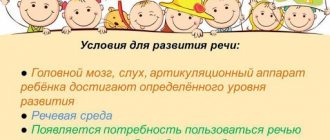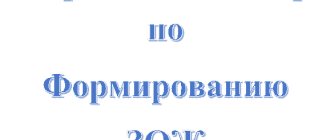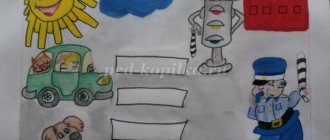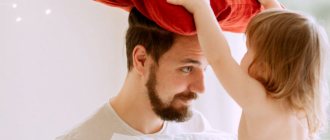Open lesson of a teacher-psychologist in an elementary school. Abstract
Outline of an open lesson, master class in psychology “Gymnastics for the mind”
Prepared by: educational psychologist Nesterova Yu.M. Goal: Development of fine and gross motor skills, concentration and stability of attention, logical thinking, memory, interhemispheric interaction. Objectives: Educational:
1. Teach how to perform exercises on interhemispheric interaction;
2. Teach to coordinate your actions in accordance with the standard. Developmental:
1. Develop gross and fine motor skills, interhemispheric interaction;
2. Develop higher mental processes (speech, attention, thinking); 3. Develop cognitive interest; 4. Develop creativity. Educational:
1. To develop the ability to work in a team.
Structure of the lesson: Organizational part;
Main part (practical); Reflection. Progress of the lesson
1. Organizational part.
You and I know how important the successes or failures of the first years of education are for a child’s “school destiny.”
During this period, he develops not only basic knowledge and skills. The main thing is that he is still “learning to learn”, to interact with teachers and classmates. It is during this period that he develops an attitude towards himself as a student. In recent years, school curricula have become more complex. The primary school program is strengthened by additional subjects. And the child, for one reason or another, is not ready for the conditions of the “mass” general education class, finds himself in an unenviable position. During the learning process, anxiety, self-doubt, and fear of a bad grade become his constant companions. Quite often the result of this is the formation in the child of a so-called “orientation towards failure.” There are a lot of inattentive and disorganized children, unable to concentrate and correctly complete the proposed work. Such children read poorly, write slowly and clumsily, making a large number of mistakes that adults call “ridiculous.” There are also children who have difficulty in counting and solving mathematical problems. In most cases, this is not due to the fact that the child is not trying or does not want to learn and be successful. Psychological analysis of the reasons for persistent school failure shows that in a fairly large number of children, difficulties are associated with the underdevelopment to the required level of a number of psychophysiological functions associated with the peculiarities of the anatomical structure of the brain and its functioning. The brain can be called a computer, because its capabilities are limitless. Throughout the entire period of life, a person learns something new; a lot of information can be stored in his head. He remembers only what he needs, and what is never useful is “removed” forever. The brain consists of two hemispheres - right and left. Each side is assigned its own functional features - everything is analyzed in strict order, remembered or deleted. The left side is responsible for logic. Language skills, solving logic circuits, mathematical operations, calculating integers and fractions, keeping track of time - all this is the work of the left half of the brain. Therefore, to improve children's performance in school or to improve overall development, we must develop the left side of our “computer”. So, how to develop the left hemisphere of the brain? It is necessary to do the following: • Work on the development of logic - study mathematical algorithms, practice logical thinking • Solve complex geometric problems. Studying a science such as mathematics is impossible without a well-developed left half of our brain • Solve puzzles and crosswords - when analyzing actions and composing words, the left hemisphere works better than the right • A left-handed person needs to do everything with his right hand: write, draw, eat. It is necessary to use the right side of the body. Important: Try not to focus on the development of one of the halves of the brain. It is the work of both halves of our brain “computer” that is valuable. Develop the left and right hemispheres of your brain at the same time. We have figured out what the left half of the brain is responsible for, now we need to work on developing intuitive abilities and creative thinking. By developing the right half, we cultivate a holistic view of the world and reality. How to develop the right hemisphere of the brain? Do the following: • Listen to music - it should be classical music, not rock or pop • Draw, write poetry, compose music. Any creativity helps the development of the right half of the brain Advice: Tune in to creativity, believe in your capabilities, and the result will not take long to arrive.
This division of functions ensures the mutual complementarity of the hemispheres. If interhemispheric interaction is not formed, there is no full exchange of information between the right and left hemispheres, each of which comprehends the outside world in its own way. The right and left hemispheres are associated with the organization of movement in the opposite side of the body, as well as with the reception and processing of all visual, auditory, tactile, kinesthetic information coming from the opposite half of the body. For both hemispheres to work together, their functional connection is required. It is formed during infancy, during crawling, thanks to the constant cross movements of the arms and legs. If the crawling period is shortened, then coordination of movements, coordination of the activities of the hemispheres among themselves, and coordination of the brain and body as a whole are not sufficiently developed. By developing the coordination of movements and motor skills of the child, we create the prerequisites for the full functional development of many mental processes. The development of interhemispheric interaction is the basis of a child’s intellectual development. I would like to draw special attention of teachers to the need for timely formation of these psychophysiological functions while preparing children for school. It is also very important to early identify this particular area of difficulty in underachieving children in order to organize and conduct correctional classes. I bring to your attention the author’s program “Gymnastics for the Mind”, consisting of training sessions that affect memory, observation, reaction speed, and thinking, which can be used quite effectively both in preparing a child for school and for correctional purposes in younger schoolchildren. Primary school age is most favorable for the intensive development of memory, attention, creative imagination, and cognitive activity. The game helps children quickly and easily master educational material, having a beneficial effect on the development of intelligence and the personal-motivational sphere. By training the mind, a person becomes observant, quick-witted, insightful, shrewd, far-sighted, inventive, resourceful, witty, and also acquires many other important and useful qualities. 2. Practical part.
1. Exercise to develop motor skills and attention. The development of fine motor skills plays an important role in the overall development of a child. Fine motor skills develop from newborns. First, the baby examines his hands, then learns to control them. First, he takes objects with his entire palm, then only with two (thumb and index) fingers. Then the child is taught to hold a spoon, pencil, and brush correctly. Fine motor skills have a very important feature. It is associated with the nervous system, vision, attention, memory and perception of the child. The development of fine motor skills and speech development are very closely related. And this can be explained very simply. In the brain, the speech and motor centers are located very close to each other. Therefore, when the motor skills of the fingers are stimulated, the speech center begins to activate. That is why, for the timely development of a child’s speech, it is necessary to pay great attention to the development of fine motor skills. Fine motor skills directly affect manual dexterity, handwriting, which will be formed in the future, and the child’s reaction speed. If you can’t do it with both hands at once, then start with your leading hand. Task:
learn to do it at high speed.
In a series of exercises, learn to quickly switch from one to another. • Rings • I am the captain - I have a plan • Fist-palm • Contact - there is contact • Horns-feet • Thumb and little finger • Fist-rib-palm 2. Drawing with two hands This kinesiological exercise is based on three basic principles of strengthening interhemispheric connections . • Variety. The brain begins to actively develop when we focus on performing unusual movements. This also applies to fine motor skills and the articulation of new sounds, movements of the arms and legs. • Simultaneity of actions. Both hemispheres must participate in the process, because the left, as is known, controls the right half of the body, and the right controls the left, the left is responsible for speech, and the right is for coordination of movements. • Work with both hands. Any exercises performed with both the left and right hands help strengthen neural connections and create new ones. This could be drawing, playing a musical instrument, or building towers from a construction set. Drawing with two hands is useful for both children and adults. The exercise helps develop a sense of symmetry, reduce anxiety, and speed up the process of correcting dysgraphia, dyslexia, and speech development.
3. Schulte tables Schulte tables are tables with randomly located objects, used to develop attention and the speed of finding these objects in a certain order. Exercises with tables can improve peripheral visual perception.
4. Find errors and differences
Find the differences
5. Warm up for the eyes. Oculomotor exercises allow you to expand your field of vision and improve perception. Movements of the eyes and tongue develop interhemispheric interaction and increase the energy level of the body. • Directions • Eight + language • Last name first name patronymic
6. Breathing exercises Breathing exercises improve the rhythm of the body, develop self-control and volition. • Inhale through the nose, hold, exhale through the mouth. • 7 candles + relaxation music 7. Multi-colored test. Attention is the process of regulating incoming information in terms of priority for the subject and the execution of assigned tasks. It can be voluntary or involuntary. Just like Schulte Tables.
8. Anagram and rebus Anagram is a technique that consists of rearranging the letters of a certain word (or phrase), resulting in another word or phrase. An example of a pair of words made up of one set of letters: flour - kuma. You cannot add or remove letters.
Rebuses
9. Tongue twisters + walnuts 10. Alphabet
On a piece of paper, write the letters of the alphabet, and under them L, P or V. Letters from the upper lines are spoken out loud, and from the lower ones - done with your hands (L - left hand rises up, P - right hand rises up, B - both hands rise up ).
Doing all this at the same time is difficult, although it seems simple at first glance. Download Summary of an open lesson in psychology “Gymnastics for the mind”
We recommend watching:
Conversation of a teacher-psychologist with students in grades 6-7 Announcement of a methodological guide: Phenomenology of childhood anxiety in cases of hearing impairment: theory Program for psychological support for families of children with hearing impairments Work with the teaching staff of the school
Similar articles:
Summary of a psychology lesson in grades 4-5
Open lesson by educational psychologist “A Place in the Sun”
OPEN CLASS OF TEACHER-PSYCHOLOGIST
"A place under the sun"
Developer:
teacher-psychologist of the municipal educational institution "Secondary school in the village of Ivanteevka, Ivanteevsky district, Saratov region"
Kalenova Ksenia Andreevna
Relevance:
Currently, it is very important for teenagers to realize that they are in demand in society and to have life goals that have personal significance. It is important to help teenagers see how their choices can affect their future life and success in it, to find ways to achieve life goals, to interest them in realizing their plans, to teach them not to give up what they want when they fail, but to continue to move forward. This topic of the lesson is relevant because in adolescence, students become more interested in themselves, in their capabilities, abilities; adolescents are quite open to help from adults in overcoming difficulties, problems, and making decisions.
Audience:
teenagers aged 12 to 18 years. The quantitative composition of the group is from 6 to 10 people.
Target:
prevention of suicidal behavior, formation of the ability for self-knowledge, self-development and self-realization, development of motivation to achieve positive life goals.
Tasks:
creating conditions of emotional comfort;
prevention of suicidal behavior without using the word “suicide” during the lesson;
development of self-awareness in adolescents;
increasing communication skills and confidence;
updating life goals and increasing motivation to achieve them;
promoting group cohesion;
development of reflection.
Expected Result:
teenagers will acquire a desire for self-knowledge, self-development and self-realization, get acquainted with their inner world, gain experience in communication, listening skills, and reflect on their life values and guidelines.
Structural components of the lesson:
1. The introductory part is aimed at relieving emotional stress, creating a favorable, friendly atmosphere, psychological comfort and safety for each participant.
2. The main part is aimed at developing new knowledge and ideas, acquiring new skills and attitudes, constructing and practicing a personal strategy of behavior, comprehending the experience gained, and forming a value-significant personal concept of interaction with the world.
3. The final part includes summing up, intellectual and emotional reflection.
Contents of the lesson
Introductory part – 15 minutes
The teacher-psychologist welcomes students:
"Hello! Glad to see you again today. It’s spring outside, the first flowers are blooming, the sun is shining warmer. This is reflected in my good, pleasant and fresh mood, which looks like a clearing of the first yellow snowdrops.
Each of you has a different mood today. Perhaps it has some interesting color, shape, or smell. Think about your mood now.
In front of you you see many colorful shaggy wires. Using them, please depict an image of your mood. You can use several of these wires and complement the image of your mood with additional details: ribbons, beads.”
Discussion:
“I see you have finished creating an image of your mood today. Tell us why your mood image looks the way it does today, and how does it relate to your mood?
*Add. questions. Imagine that your mood began to deteriorate (improve). What could cause this to happen? How does your mood become? What will change first in your mood pattern?
Questions:
How was your work?
What emotions does the resulting image of your mood evoke today?
What's your mood today?
What's your mood like?
Let's fantasize a little, where does the image of your mood live?
How does it receive energy and charge?
What is its purpose?
What features does it have?
Who is looking after him?
How does your mood pattern today compare to you in life?
Main part – 25 minutes
Educational psychologist:
“Human life is full of many colors. And how good this picture of life turns out depends on the desires, goals, beliefs and actions of the person himself. Some devote themselves to creativity, while others scientifically explore patterns and relationships. Each of us is free to choose our own life guidelines. As we consciously answer the questions “what do I want”, “what can I do”, “what do I need now”, “who can I turn to for support”, “who can I give my support to”, We are taking our first independent steps towards finding our “place in the sun.”
How do you understand the expression “A place in the sun”? Teenagers' answers
.
You gave correct, quite accurate and interesting answers. The phraseological dictionary of the Russian language defines the expression “a place in the sun” as the possibility of a full-fledged and full-fledged existence. What do you think our lesson today will focus on? Teenagers' answers.
Educational psychologist:
“The body parts of various robots are laid out on the table.
The head is thoughts;
The body is feelings;
Legs are actions;
Imagine that you are robot creators. Each of you needs to create your own robot that looks like you. Please come up with a specific purpose for your robot, what it was created for, what goals and functions this robot has, what it can do best, how it can be useful to others. Color the robot the way you want using colored pencils, markers, pastels and clay." Students create their own robot, glue its body parts, and paint it.
In a circle:
“Now that your robots are ready, you need to introduce them.
This needs to be done in the following way: you need to imagine yourself in the image of your robot, its intonation, gestures, and facial expressions. Then present yourself on his behalf, in other words, be in the role of your robot and tell who he is, what he can do, what functions he has, what he likes, why he turned out the way he did, what he does, who he communicates with , how it is useful to others, what its purpose is.” Students talk about their robot and its purpose.
Educational psychologist:
Tell us how it worked for you?
Which part of the robot's body was the most difficult for you to choose? Why?
What is the purpose in life of your robots?
What emotions does the resulting image evoke?
Please tell me how you worked in pairs?
How is each of your robot similar to yourself?
Final part – 20 minutes
Educational psychologist:
“Look how different you have made your robots.
What do you think this could depend on?” Teenagers' answers.
Indeed, each person has his own worldview, his own goals, abilities, his own social circle, his own interests and hobbies. They can be useful not only for ourselves, but also for the people around us, in other words, when we communicate with each other, we have the opportunity not only to learn something new from someone, but also to convey our personal experience, which will be important, necessary and interesting for others.
The sun is shining brightly in our office. I suggest finding a place for your robots under it. Mark this place with colored crayons. Students glue their robots under the sun.
Reflection
Educational psychologist:
“In the meantime, our lesson is ending.
Please tell us how was your work today?
What emotions did our meeting today evoke?
What was the topic of today's lesson for you?
What new did you learn about yourself today?
Describe your impression of the lesson in one word.
In conclusion, I would like to wish you easy and interesting roads, a passionate desire to achieve your goals and sustainable motivation. Remember that the one who walks will master the road.”





